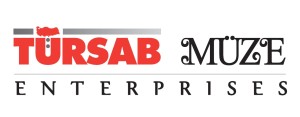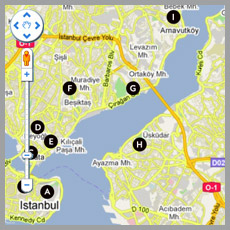By Sevinç Akyazılı
The Rahmi Koç Museum is not an ordinary one, it totally subverts the classical notion of museum. Displayed are submarines instead of statues, steam-engine automobiles instead of paintings. Various objects of curiosity, for instance one of world’s oldest celestial spheres and a military aircraft which took part in World War II (WWII) can be admired as parts of an extraordinary collection in the museum located at the shores of the Golden Horn. Archaeological artefacts, paintings and sculptures, avant-garde productions of contemporary art, those are the images we spon-taneously associate with the idea of a museum. However, in this case, we are faced with something else. Pioneers of private muse-ums in Turkey, the Koç family put once again their signature un-der yet another innovative project with a challenging collection of industrial exhibits. . It includes a real submarine and a real aircraft from WW II, classic automobiles, an old style diver’s wet suit.The buildings housing the museum are themselves icons of industrial archaeology, which makes it all the more appropri-ate that they host this peculiar collection.
Indeed, the complex itself is classified as historical monument. It served as the anchor foundry (Lengerhane) of the Ottoman Navy and was constructed on the 12th century foundations of a Byzantine building during the reign of Sultan Ahmet III. The roof of the Lengerhane was largely destroyed by a fire in1984 and the building was effectively abandoned until it was purchased by the Rahmi Koç Museum and Culture Foundation in 1991 and underwent a thorough restora-tion. The original building was supplemented by an underground gallery reached by a long glazed ramp, and finally opened in December 1994.
The first phase of the Museum rapidly outgrew itself, and in 1996 the Hasköy Dockyard, then just a ruin on the shores of the Golden Horn opposite the Lengerhane, was pur-chased. 14 derelict buildings plus the historic ship cradle and lathes were faithfully restored to their original condition, and the second phase opened to the public in July 2001. With its more than 11,250 square metres of galleries, its 7,000 m2 of open air space and its unique collection consisting of 12 thousand 954 exhibits, the Rahmi Koç Museum is an unparalleled project in Turkey. The “flagship”, so to speak, of the museum’s collection is the Uluçalireis Submarine.
“Uluçalireis” Submarine :
Built in 1944 at the Portsmouth Shipbuilding Yard, the 93 meters long submarine weighing 2 thousand 400 tons was commissioned initially by the US Navy. It participated actively in WWII. It fought against the Japanese submarines in the Pacific. Later it was trans-ferred to the Turkish Navy on 2nd July 1971. Acquiring the name of one of the most illustrious admirals of Turkish Naval history, Uluç Ali Reis, the submarine served in the Turkish Navy for 30 years. Following its decommissioning it was donated to the Rahmi Koç Museum in 2002.
The Fenerbahçe Ship :
The ship Fenerbahçe, together with its twin Dolmabahçe, was built in 1952 in Scotland, at the William Denny & Brothers Dum-barton shipyard in Glasgow. Entering in 1953 in the service of the Istanbul urban maritime transportation com-pany, it served the Sirkeci-Prince Islands-Yalova-Çınarcık line for many years and sailed for the last time on 22 December 2008 and joined the Rahmi Koç Museum thereafter.
ESCAPED THE HURRICANE KATRINA AND TOOK REFUGE AT THE GOLDEN HORN
Recently a new piece joined the museum: a railcar built in Italy in 1937.An ordinary vehicle at first sight. But it has behind it a tragic adventure. The rail bus model La Littorina, made by automotive company Fiat was a victim of the Katrina Hurricane which hit the USA in 2005. The rail bus which suffered extensive damage during the hurricane, was brought to Turkey following a two months long sea trip over the Atlantic Ocean. The railcar was repaired on the outside by FIAT TURKEY (TOFAŞ) and restructured and refurbished on the inside by the experts of the Rahmi Koç Museum in strict compliance with its original configuration. But, what is the story behind it, why did the rail bus end up in this museum? The answer to this question was delivered personally by Mr. Rahmi Koç himself at the inaugural ceremony held for La Lit-torina: “A museum’s owner whom I have known for many years, Mr. Mitchell Wolfson, who runs two private museums, one in Genoa, the other in Miami, who paid twice visits to our museum, and whose visits I reciprocated as well, told me once the story of a rail bus he purchased from the Italian Railways in 1998 and sent to a railroads museum in Tennessee, USA as an exhibit, after having it restored for 100 thousand dollars.
We learned following the devastation caused in 2005, by the Katrina Hurricane in western USA that the museum in Tennessee housing the railcar and the railcar itself were affected by the Katrina disaster. We dis-cussed the issue with Mr. Wolfson and reached the common decision that, under the condition that we would commit to bear the transportation and restoration costs for the old vehicle, La Littorina would remain as a temporary exhibit for ten years at our museum.” The rail bus who crossed oceans, who suffered damage from Katrina is now at its new more peaceful location at the Golden Horn.
This article has originally appeared in “Müze” Magazine, published quarterly with the contributions of the Ministry of Culture and Tourism. We would like to thank TÜRSAB Museum Enterprises for sharing this piece with Istanbul Digital Platform followers.




















